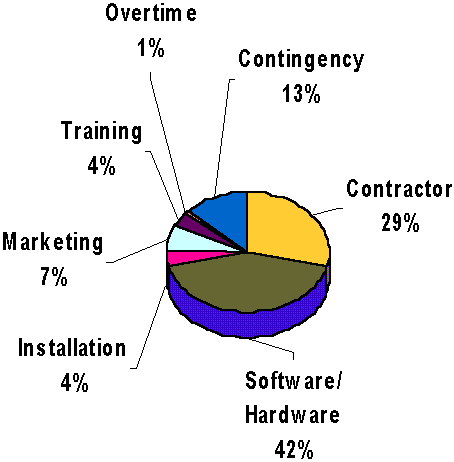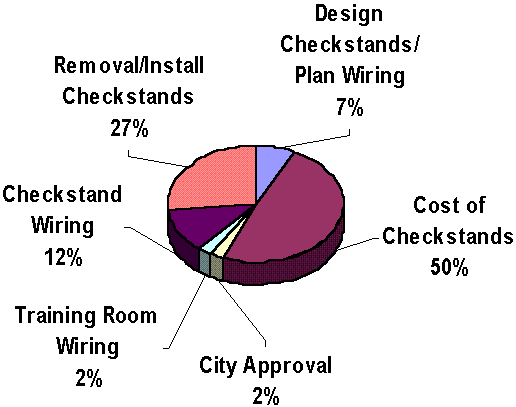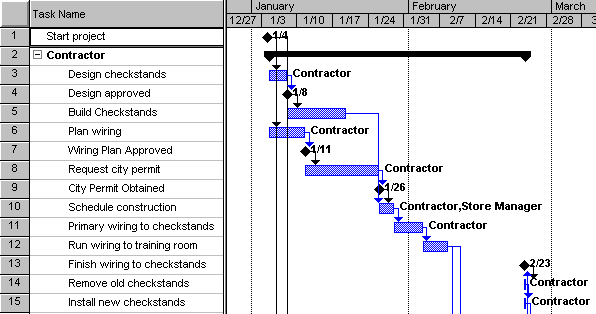
Project Management X470
Instructor: Edmund Lam 11/09/98______________________________________________________________
Implementing a Point of Sale (POS) System at a Retail Food StorePROJECT TEAM 4 MEMBERS
| David Lee |
| Alan Schaer |
| Colm Kennedy |
| Marie Murphie |
| Cecile Brun |
| Thomas Albert |
Trader Bob’s began in 1985 as a gourmet mini-supermarket targeted at the affluent customer base in the San Ramon Valley. Founded by three friends, it brought to the East Bay a convenient location for purchasing delicacies that previously could only be found in the specialty stores of Berkeley and Oakland. With its collection of fresh and exotic vegetables, a wide variety of cheeses, and easy-to-prepare cuisine from around the world, Trader Bob’s easily distinguished itself from all of the nearby supermarkets. With fine food at reasonable prices, Trader Bob’s name spread quickly by word of mouth and became an immediate success.
The major supermarket chains in the area took notice and started to made serious inroads into Trader Bob's market, offering a greater number of upscale, exotic, and luxury products and expanding their wine, cheese and bread offerings.
Realizing the threat, Trader Bob’s commissioned a study to focus on the top priorities of their current customers as well as how to attract new customers. A market research company conducted a survey of Trader Bob’s customers as well as their competitor's customers. Trader Bob management assembled a team of experts to analyze the survey results and came up with a solution. The team of experts propose the purchase and implementation of a Point of Sales (POS) system to resolve customer issues and bring additional benefits to the business.
The following table shows customer issues and how the proposed automated Point of Sale (POS) project aims to resolve them.
Customers Want: |
Solution |
Quick Checkout |
New checkout counters would be installed with bar-code scanners. These would speed up the checkout process significantly, compared to the current practice of manually entering prices. Using bar-codes instead of the manual price sticker would reduce the frequency of "Price checks", another major cause of delays at Trader Bob’s checkouts. |
Payment Options |
Trader Bob’s currently offers payment by cash or check.. The new registers would accept more types of payments, such as ATM and credit cards and could provide service for check truncation (payment and automatic approval) to speed up the verification and conversion of checks. |
One-stop shopping for perishables (fresh fruit and vegetables), staple (milk, bread, cheese, cereal), and specialty (exotic/ethnic/luxury foods) items. |
Registers hooked to a database, combined with "Preferred Customer Reward" cards, improve Trader Bob’s inventory tracking and sales data analysis. Inventory control, coupled with good ordering practice, eliminates unpopular items to free up shelf space for items customers demand. |
Competitive prices, especially on new or unique items. |
After analyzing sales information, the marketing department launches advertising campaigns to target individual clients based on purchasing history and budget. Preferred Customer Reward cards provide clipless coupons that match or beat competitors' prices. |
Project Goals
four cash registers and barcode scanners
Additional Benefits to the Business
Support
Senior Management would be willing to budget resources for a solution that address the issues raised in the customer survey.
Physical Space
Store floorspace is adequate to replacing the manual checkstands with automatic checkstands that are slightly larger.
Resources available for the project
The assistant manager acts as project manager. She oversees implementation and works closely with the Contractor and Point of Sale Vendor, who will provide an onsite trainer.
Due Date
POS implementation is scheduled to be completed by March 1, 1999.
Overtime
Each of the store clerks will receive overtime pay for the training, which will occur in addition to normal work hours.
Technical Support and Training
The Point of Sale vendor will station a technician on-site for the Grand Opening to ensure the equipment runs.
The trainer from the vendor will be available as needed by telephone for six weeks after training is complete. The systems support contract identifies long term support options.
Holidays
There are no holidays or other breaks observed during the implementation of this project.
Project Decisions
Based on the Project Assumptions, management made the following Project Decisions.
Start After Hannukah/Christmas/New Year's Day
Use a Single Full Service Point of Sale System Vendor
Use Our Proven Building Contractor Instead of Going Out for Bid
Alternatives Considered
The goal of implementing a POS system is to improve throughput, increase inventory control, reduce merchandise shrinkage (theft) and improve marketing. The following is a list of alternatives that were eliminated.
More Personnel Training: Due to the relatively high turnover of checkers, we decide that money spent in training would be best used to increase productivity with an automated system.
Hire more checkers, stockers and price taggers: The POS system will enable the company to reduce the personnel who are now performing these duties manually. Instead of paying checkers to report what we sold and inventory clerks to report what needs to be re-ordered, the automated system package reports sales, re-ordering needs, and summerizes sales trends.
Don’t try to compete in the mainstream, one-stop shopping market: Become more specialized in luxury items. Less quantity, more quality. Unfortunately surveys suggest that fewer customers are prepared to shop at specialty stores for different types of food merchandise and would rather get all of their food at the same place. Large supermarkets are already starting to provide that "One-Stop" shopping experience with greater quantity of products and quality luxury items.
Because of the high visibility of this project and the potential for disruption of customers and revenue, it is critical that it be managed well and completed on schedule. In-store work should cause as little disturbance as possible.
One of the most critical parts of our project is the installation of the new checkstands. To minimize the disturbance to weekend business, which generates the highest revenue, we will close the store early on a Monday or Tuesday and complete the installation by mid-morning (or early afternoon) of the next day.
The POS system components will first be installed in the training room and connected to the server. This allows us to verify functionality (and rectify any problems) for each of the four checkstands before moving equipment onto the store floor. If a component cannot be repaired in the store (for example, if we need a replacement part), the "Grand Re-Opening" can occur on schedule without that component.
The central server, however, remains a risk because it could be a single point of failure. We therefore have written assurance from the vendor that a backup server will be ready for loan, if necessary, on the day of Grand Re-opening.
We have scheduled the installation of the new checkstands on the store floor to be done several days before the "Grand Re-opening". By doing this we have provided plenty of time to do additional testing and solve any unforeseen problems with these devices before the re-opening.
Work Breakdown Schedule

Total Budget Pie Chart

Contractor Pie Chart

Itemized Dollar Amounts
| Contractor | 41,000 |
|
| Design | 3,000 | |
| Order | 20,000 | |
| City Permit | 1,000 | |
| Wire Training Room | 1,000 | |
| Wire Checkstands | 5,000 | |
| Replace Checkstands | 11,000 | |
| Software/Hardware | 60,000 | |
| Installation | 6,000 | |
| Marketing | 10,000 | |
| Training | 5,000 | |
| Basic Project Costs | 122,000 | |
| Overtime | 1,600 | |
| Subtotal | 123,600 | |
| 15% Contingency | 18,440 | |
Grand Total |
142,140 |
Network Diagram/Gantt Chart





| Marie Murphie | marie.murphy@hpmg.com | 925 934-9388 home; 925 552-6841 work | Health Care Specialist |
| David Lee | clee8899@aol.com | 510 487 8899 | Vice President |
| Alan Schaer | aschaer@iguard.com | 925 556-4100 x 1335 | Project Manager |
| Cecile Brun | cmbrun@pacbell.com | 925 823-0531 | Manager |
| Colm Kennedy | colmk@srprecision.com | 510 360-2859 | Production Supervisor |
| Thomas Albert | talbert@WORDesign.com | 925 209-5505 | Technical Communicator |